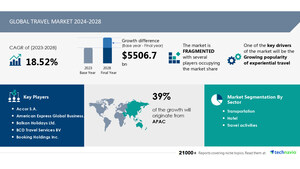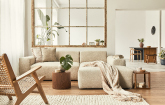NEW YORK, Nov. 22, 2024 /PRNewswire/ -- Report with market evolution powered by AI - The luxury furniture market in middle east size is estimated to grow by USD 413.02 million from 2024-2028, according to Technavio. The market is estimated to grow at a CAGR of 4.48% during the forecast period. Increase in number of office spaces is driving market growth, with a trend towards increasing acceptance and demand for eco-friendly products. However, growing prominence of furniture rentals poses a challenge.Key market players include Anna Casa Ltd., Auraliving, B and B Italia SPA, Boca Do Lobo, Defure Furniture Trading LLC, DelightFULL, Giorgio Armani S.p.A., Haworth Inc., Inter IKEA Holding BV, Lazzoni Furniture, Luma Inc., LVMH Moet Hennessy Louis Vuitton SE, MillerKnoll Inc., Minotti S.p.A., Natuzzi SpA, Next Space LLC, Pan Emirates Home Furnishings, Poltrona Frau SPA, Scavolini S.p.a., and Workspace.
Key insights into market evolution with AI-powered analysis. Explore trends, segmentation, and growth drivers- View Free Sample PDF
Luxury Furniture Market In Middle East Scope |
|
Report Coverage |
Details |
Base year |
2023 |
Historic period |
2018 - 2022 |
Forecast period |
2024-2028 |
Growth momentum & CAGR |
Accelerate at a CAGR of 4.48% |
Market growth 2024-2028 |
USD 413.02 million |
Market structure |
Fragmented |
YoY growth 2022-2023 (%) |
3.88 |
Regional analysis |
Middle East |
Performing market contribution |
Middle East at 100% |
Key countries |
Saudi Arabia, United Arab Emirates, Kuwait, Oman, and Rest of Middle East |
Key companies profiled |
Anna Casa Ltd., Auraliving, B and B Italia SPA, Boca Do Lobo, Defure Furniture Trading LLC, DelightFULL, Giorgio Armani S.p.A., Haworth Inc., Inter IKEA Holding BV, Lazzoni Furniture, Luma Inc., LVMH Moet Hennessy Louis Vuitton SE, MillerKnoll Inc., Minotti S.p.A., Natuzzi SpA, Next Space LLC, Pan Emirates Home Furnishings, Poltrona Frau SPA, Scavolini S.p.a., and Workspace |
Market Driver
The Middle East luxury furniture market is thriving, with trends including high-demand for lighting, tables, chairs and sofas, accessories, and bedroom furniture. Real estate developments and markets in the real estate sector continue to drive growth in the residential and commercial segments. Oil price fluctuations impact the market, but consumers remain interested in luxury furniture pieces made from high-quality materials like metal, glass, and wood. Home renovation and decoration projects in homes, offices, hotels, restaurants, and schools fuel demand for designer furniture. Tech-savvy consumers seek automation and digitalization, leading to a focus on smart devices and multifunctional furniture. Personalized shopping experiences are in vogue, with flagship stores and specialty stores offering unique furniture pieces. Online sales via home centers, departmental stores, e-commerce websites, and RTA (Ready-to-Assemble) furniture are on the rise. Wood and leather remain popular choices for their aesthetic appeal and durability. The market caters to various sectors, including residential, commercial, office, hospitality, and school furniture. Comfort is a key consideration, with marketing campaigns and social media platforms promoting the latest product designs in living rooms, kitchens, outdoor spaces, bathrooms, and bedrooms. Plastic furniture is also gaining traction for its affordability and versatility. Overall, the market is diverse, with trends reflecting the needs and preferences of consumers in the region.
The luxury furniture market in the Middle East is experiencing growth due to the rising demand for eco-friendly furniture. This trend is driven by the benefits of using sustainable and recycled materials in furniture production. Eco-friendly furniture contributes to cleaner air and less environmental pollution by reducing the amount of waste and deforestation. Moreover, refurbished or recycled furniture helps in reducing landfills and conserving forests. The demand for recycled furniture is projected to increase due to its cost-effectiveness compared to new pieces. Various non-profit trade associations have established guidelines for eco-friendly furniture suppliers and manufacturers in the region, further promoting this sustainable practice.
Request Sample of our comprehensive report now to stay ahead in the AI-driven market evolution!
Market Challenges
- The Middle East luxury furniture market faces several challenges in various segments. In the residential sector, there's a growing demand for high-quality lighting, tables, chairs and sofas, cabinets, and accessories made from materials like metal, glass, and wood. Real estate developments and markets, as well as oil price fluctuations, impact the luxury furniture market. Home renovation and decoration projects in homes, offices, hotels, schools, and restaurants require exclusive, unique furniture pieces with aesthetic appeal and durability. Technological advancements such as automation and digitalization cater to tech-savvy consumers seeking personalized shopping experiences. The commercial segment, including offices and corporate environments, requires functional, multifunctional furniture. The hospitality industry demands comfortable, designer furniture for residential spaces. Marketing campaigns and social media platforms are essential tools for reaching consumers in the residential and commercial segments. Online sales through e-commerce websites and departmental stores are increasing, making it crucial for businesses to adapt to the global e-retail industry. The online and offline retail landscape offers opportunities for both RTA and specialty stores, catering to various customer preferences and budgets. Plastic furniture is gaining popularity for its affordability and versatility, while living room, kitchen, outdoor, and bathroom furniture remain in high demand. Smart devices and upholstery are essential components of modern luxury interior furnishings. The furniture industry continues to evolve, with a focus on comfort, product designs, and online retailing.
- The Middle East luxury furniture market faces a significant restraint due to the growing popularity of furniture rentals among consumers. Urbanization has led to an increase in demand for rented apartments and single homes, causing many to opt for rented furniture instead of purchasing. Rental prices for items like sofa-cum beds range from USD26 and above per month, depending on the material. This cost-effective alternative decreases switching costs, thereby limiting the market's growth.
Discover how AI is revolutionizing market trends- Get your access now!
Segment Overview
This luxury furniture market in Middle East report extensively covers market segmentation by
- Application
- 1.1 Residential
- 1.2 Commercial
- Distribution Channel
- 2.1 Offline
- 2.2 Online
- Geography
- 3.1 Middle East
1.1 Residential- The Middle East luxury furniture market is experiencing notable growth, particularly in the residential segment. This segment includes furniture items such as lounge chairs, ottomans, sofas, tables, outdoor seating, and bedroom and dining furniture. Major players in this sector include MillerKnoll, IKEA, and Minotti. The residential segment's growth is driven by the increasing demand for multifunctional and multipurpose luxury furniture, particularly foldable beds and extendable sofa sets. The luxury residential furniture market is categorized into living room, bedroom, dining and kitchen, and other residential furniture. The living room segment features reclining sofas, sofa cum beds, L-shaped sofas, and other items. The bedroom segment consists of king and queen beds, lounge chairs, and various storage solutions. The dining and kitchen furniture segment includes dining tables, chairs, and kitchen cabinets. New product launches are invigorating the growth of these segments in the Middle East. The luxury residential living room furniture segment comprises reclining sofas, sofa cum beds, L-shaped sofas, lounge chairs, nested tables, television units, shelves, and bookcases. The luxury residential bedroom furniture segment includes king and queen beds, lounge chairs, wardrobes, bedside tables, dressing tables, and storage solutions. The luxury residential dining and kitchen furniture segment consists of dining tables, chairs, and kitchen cabinets. Frequent product launches in these categories are driving the growth of the luxury residential living room, bedroom, and dining and kitchen furniture segments in the Middle East. Additionally, the other luxury residential furniture application segment includes outdoor furniture, kids' furniture, swings and hammocks, canopies, wall shelves, swivels, and gliders. These factors are expected to continue driving the growth of the residential segment of the luxury furniture market in the Middle East during the forecast period.
Download a Sample of our comprehensive report today to discover how AI-driven innovations are reshaping competitive dynamics
Research Analysis
The Luxury Furniture Market in the Middle East is a thriving industry, catering to the region's growing demand for high-end home furnishings. This market encompasses a wide range of products, including Lighting, Tables, Chairs and Sofas, Accessories, Cabinets, and more. The Residential and Commercial sectors are significant consumers of luxury furniture pieces, with Home Centers and Flagship Stores being popular shopping destinations. Luxury furniture is often crafted from High-quality materials such as Metal, Glass, and Wood, adding Aesthetic appeal to any space. Home renovation and Decoration projects are common applications for these pieces, with Schools, Homes, Offices, Kitchens, Outdoor areas, Bathrooms, Hospitality venues, and even RTA and Non-RTA establishments investing in them. Beds, Departmental Stores, E-commerce Websites, and other retail channels also contribute to the market's growth. With a focus on innovation and design, the Middle East Luxury Furniture Market continues to attract both local and international buyers seeking unique and sophisticated home solutions.
Market Research Overview
The luxury furniture market in the Middle East is thriving, with a focus on high-end offerings in various segments. Lighting, Tables, Chairs and Sofas, Accessories, and Cabinets are popular categories, featuring Luxury furniture pieces made of high-quality materials such as Metal, Glass, and Wood. Real estate developments and markets in the sector continue to drive demand for residential and commercial spaces, fueled by oil price fluctuations. Home renovation and decoration projects in Homes, Offices, Hotels, Restaurants, and Schools are on the rise, with a preference for unique furniture pieces and aesthetic appeal. Tech-savvy consumers seek automation and digitalization, leading to a growing trend of multifunctional furniture and smart devices. Marketing campaigns on social media platforms cater to personalized shopping experiences, with both online and offline sales channels, including Home Centers, Flagship Stores, and Specialty Stores, offering a wide range of products, from Wood and leather upholstery to Plastic and RTA furniture. Online retailing through e-commerce websites is also gaining popularity in the Global e-retail industry, providing convenience and accessibility to consumers in the residential and commercial segments. Overall, the Middle East luxury furniture market is characterized by its focus on comfort, durability, and designer furniture for various residential and commercial purposes.
Table of Contents:
1 Executive Summary
2 Market Landscape
3 Market Sizing
4 Historic Market Size
5 Five Forces Analysis
6 Market Segmentation
- Application
- Residential
- Commercial
- Distribution Channel
- Offline
- Online
- Geography
- Middle East
7 Customer Landscape
8 Geographic Landscape
9 Drivers, Challenges, and Trends
10 Company Landscape
11 Company Analysis
12 Appendix
About Technavio
Technavio is a leading global technology research and advisory company. Their research and analysis focuses on emerging market trends and provides actionable insights to help businesses identify market opportunities and develop effective strategies to optimize their market positions.
With over 500 specialized analysts, Technavio's report library consists of more than 17,000 reports and counting, covering 800 technologies, spanning across 50 countries. Their client base consists of enterprises of all sizes, including more than 100 Fortune 500 companies. This growing client base relies on Technavio's comprehensive coverage, extensive research, and actionable market insights to identify opportunities in existing and potential markets and assess their competitive positions within changing market scenarios.
Contacts
Technavio Research
Jesse Maida
Media & Marketing Executive
US: +1 844 364 1100
UK: +44 203 893 3200
Email: [email protected]
Website: www.technavio.com/
SOURCE Technavio

WANT YOUR COMPANY'S NEWS FEATURED ON PRNEWSWIRE.COM?
Newsrooms &
Influencers
Digital Media
Outlets
Journalists
Opted In






Share this article